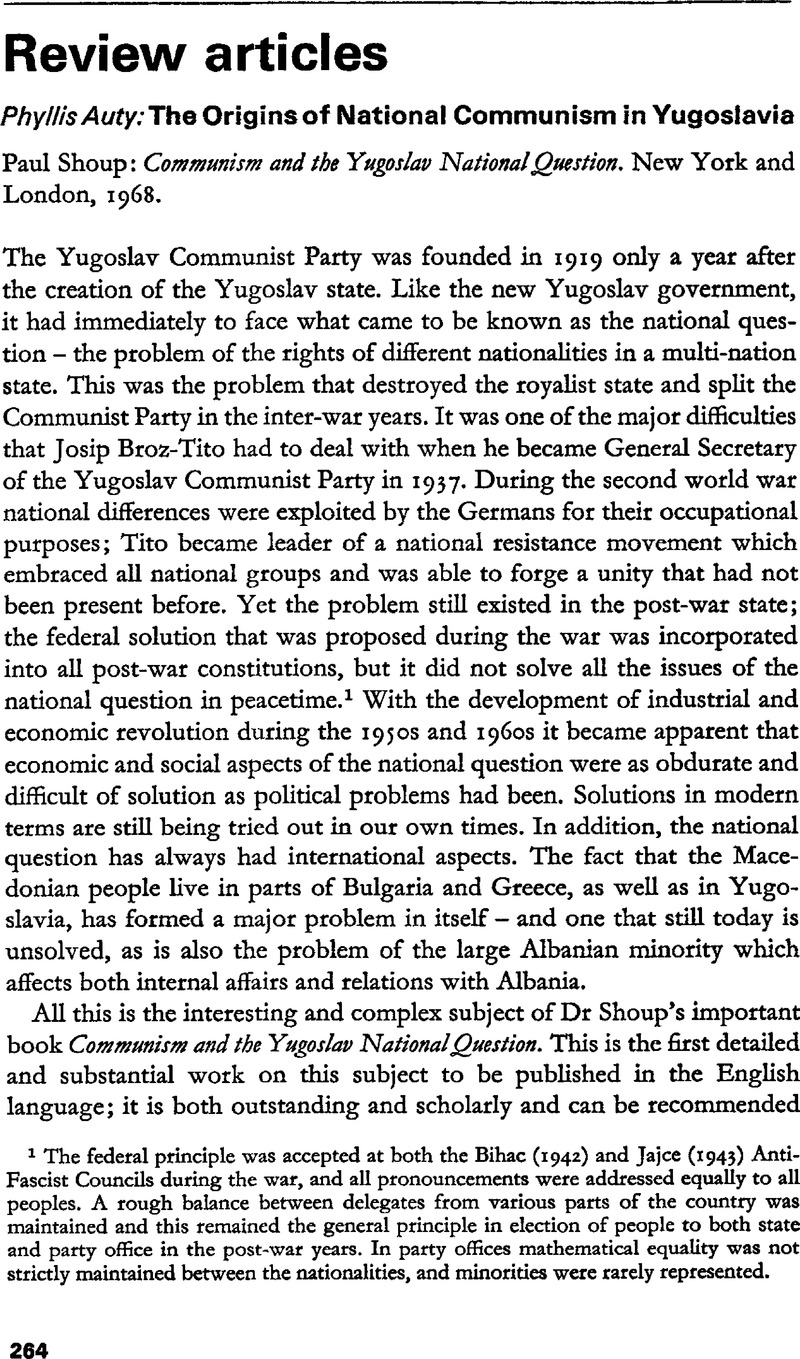No CrossRef data available.
Article contents
The Origins of National Communism in Yugoslavia
Published online by Cambridge University Press: 28 March 2014
Abstract

- Type
- Review Articles
- Information
- Copyright
- Copyright © Government and Opposition Ltd 1969
References
1 The federal principle was accepted at both the Bihac (1942) and Jajce (1943) Anti-Fascist Councils during the war, and all pronouncements were addressed equally to all peoples. A rough balance between delegates from various parts of the country was maintained and this remained the general principle in election of people to both state and party office in the post-war years. In party offices mathematical equality was not strictly maintained between the nationalities, and minorities were rarely represented.
2 Quoted in Ostović, P. D., The Truth about Yugoslavia, New York, 1952, pp. 88–89 Google Scholar.
3 432 delegates attended the unification congress held in Belgrade from 20–23 April 1919. They represented social democratic parties from Serbia, Bosnia-Herzegovina and the Vojvodina as well as a number of socialist and communist or pro-communist organizations and trade unions. All had strong regional associations, but the major dividing factors were ideological, between those who supported the Second International and those against it. See Pregled Istorije Saveza Kommunista Jugosiavije, Belgrade, 1963. pp. 38, 39.
4 The Communist Party received 198,463 votes and had 59 deputies representing all regions of the country; its share of the poll was 12.4% compared with 19.9% for the Democrats, and 17.7% for the Radicals — both Serbian parties, and 14.3% for Radić’s Croat Republican Peasant Party (HRSS). It is notable that in two wholly peasant areas, the communists had exceptionally strong support — 38% of votes in Montenegro and a high proportion of votes in the region that is today Macedonia, at that time called S. Serbia. This strong peasant support for the Communist Party was repeated in the first election after the second world war.
5 Sima Marković was born in Belgrade in 1888 and became a teacher of mathematics. He had a varied career in the Yugoslav Communist Party moving from being Comrade 1 to Comrade 10 and eventually disappearing in Russia in Stalin’s purge. He wrote a book in defence of his views — neither centrist nor federalist as he said — whilst serving a prison sentence in 1923.
6 Shoup, p. 29.
7 He attended meetings of the Yugoslav Central Committee in Vienna on 10, 11, 13, 16 and 18 August under the name of Tito — the first written record of the use of this name by Damjanović, Josip Broz. P., Tito na celu Partije, Belgrade, 1968, p. 23 Google Scholar.
8 Institut za Radnički Pokret, Belgrade, Archives KI 1937/12.
9 Shoup, pp. 41–7.
10 The challenge to Tito’s authority by Petar Miletić is mentioned in general terms in most histories of the Communist Party and was referred to by Tito in his speech to the Tenth Conference of the League of Communist, see Večernje Novosti, 18 April 1967. Miletić was leader of a revolt against Tito’s authority amongst communist prisoners in Sremska Mitrovica gaol. After his release he was aided by the Comintern to escape to Moscow where he intrigued with Bulgarian members of the Comintern against Tito but was defeated only after Tito had appealed to Dimitrov for aid. Miletić disappeared, assumed to have been arrested and liquidated, but there were rumours that he had been seen in Moscow in 1945, and that he may have been one of those working against Tito in Moscow during the Cominform break.
11 Macedonia’s development was greatly advanced by internal and foreign aid after the Skopje earthquake of 1963, and this led to greater satisfaction, and paradoxically to demands for increased national independence.
12 The secret Cornintern radio installed in a house in Zagreb in 1940 was used by Tito for sending his almost daily reports until January 1942 after which he had his own radio station in the field and maintained direct contact with Moscow until the arrival of the Soviet Military Mission in February 1944. After this his communications were channelled via the mission radio.
13 For details of these negotiations see Marjanović, J., Ustanak i Narodno-Oslobodilački Pokret u Srbiji, 1941, pp. 127, 128, 354–74Google Scholar, and Marjanović, J., ‘Prilozi Istoriji sukoba narodnooslobodilačkog pokreta i četnici Draže Mihailoviča u Srbiji 1941 godine’, in Istorija XX Veka, Zbornik Radova, 1, 1959, pp. 191–201, 217–219 Google Scholar.
14 Tito’s interview with this reviewer, October 1968. See also Djilas, M. Conversations with Stalin, London, 1962, pp. 120–4, 155–68Google Scholar.
15 Shoup, pp. 227ff.
16 Interview with Tito, October, 1968.


